When did you last charge or change the battery, how much have you used it so far? Questions that typically lead to replacing the battery, or charging it even if it doesn't need it. The DD (Digital Display) series from JETBeam feature the first lights with integrated multi-segment LED displays. This display informs the user of the exact mode they are using and a count-down battery level figure, so you always know how much power you have left. No surprises, and no guesswork – sounds good.
On test is the single AA powered DD light, the DDA10.
Initial Impressions:
The square head makes the DDA10 seem a little chunky at first for a single AA light, but the square cross section makes it sit in the hand nicely and is a fantastic anti-roll feature.
Of course this square head is needed to incorporate the extra circuitry to drive the display to house the display itself.
Having the display panel is one thing, but the panel also incorporates the power switch making this very intuitive to hold and operate. There is no tail switch, just the side switch.
The finish is flawless and build quality seems excellent.
Its shape, quality of finish and weight, all go together to make this a difficult light to put down.

What is in the box:
The DDA10 arrives in a cardboard box.
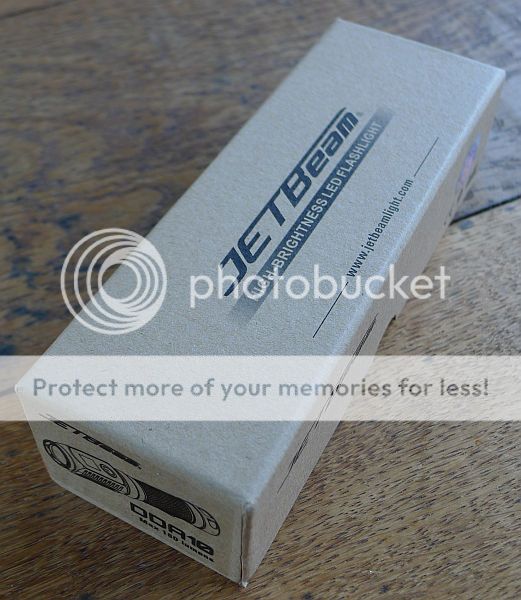
There is a foam cut out to protect the DDA10
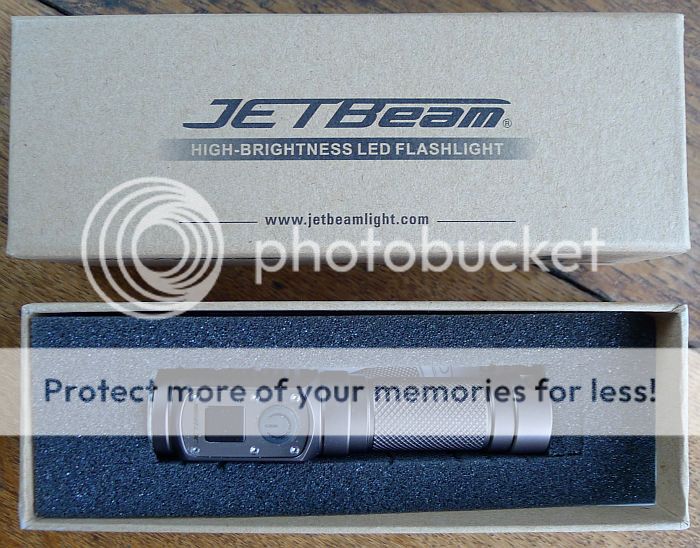
Included are the DDA10, pocket clip with spare screws, allen key, lanyard, instructions, and a spare o-ring.
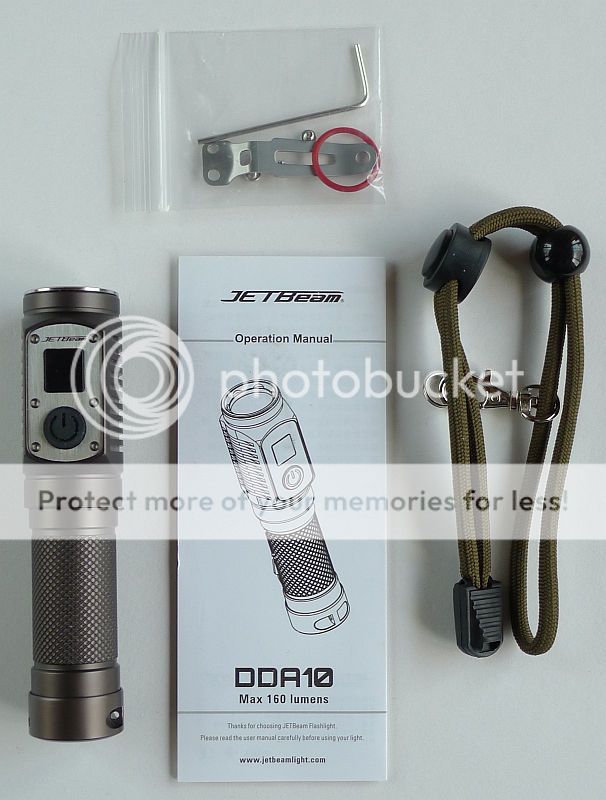
Taking a closer look and looking inside:
The DDA10'a display and button is secured by six small torx screws
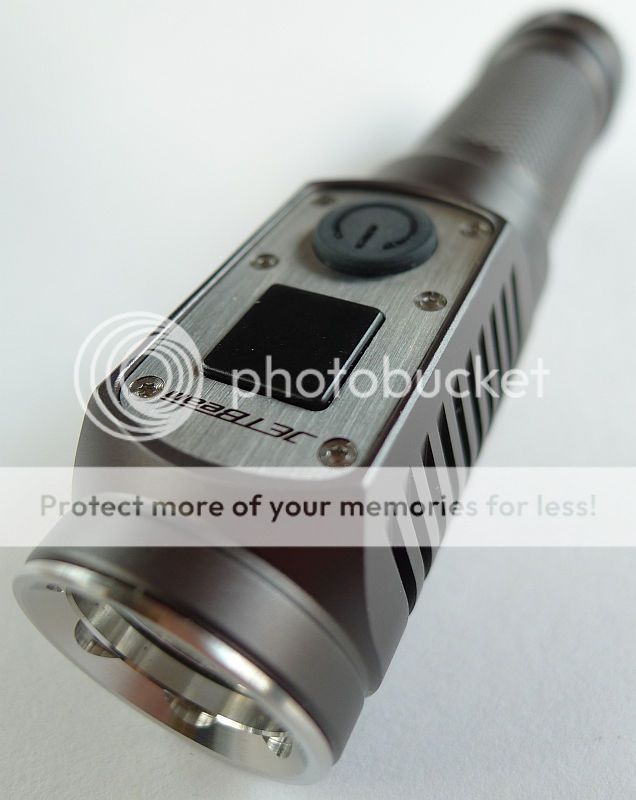
After fitting the pocket clip, one of the design features becomes more obvious, that of the rotating tail cap. This allows the user to position the pocket clip at any point around the body of the DDA10.
Underneath the square head, the model information is printed onto the anodizing. The two sides of the head have small fins for heatsinking.
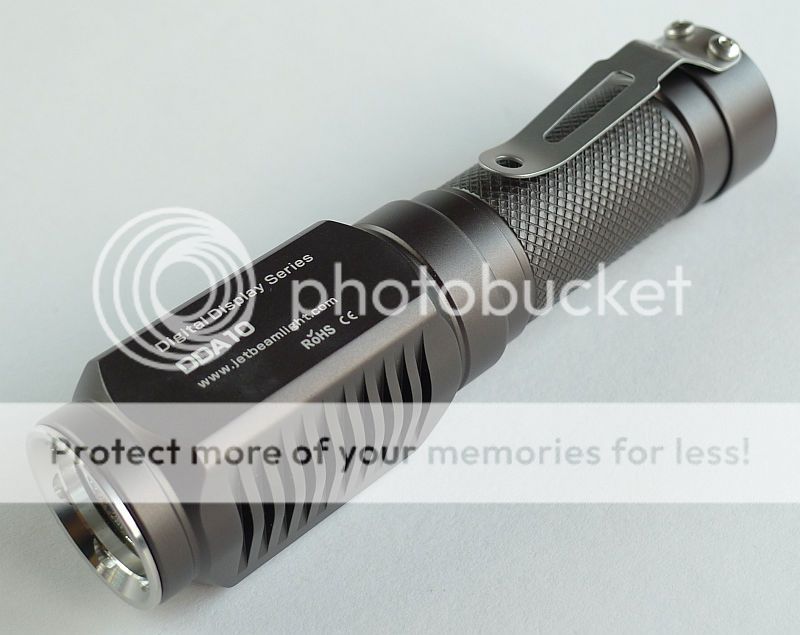
The power switch has a rubber boot and is an electronic click switch.
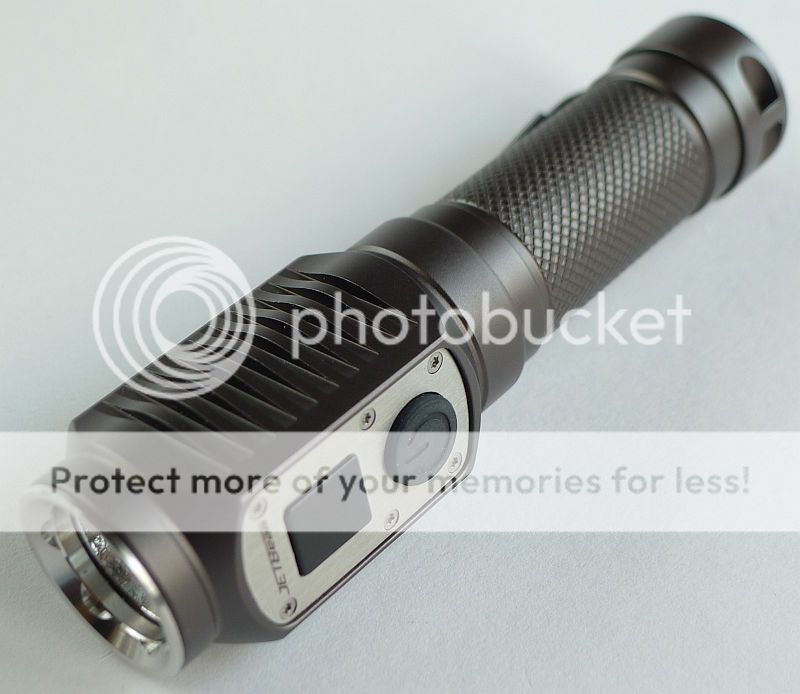
For the emitter. The DDA10 has an XP-G2 LED
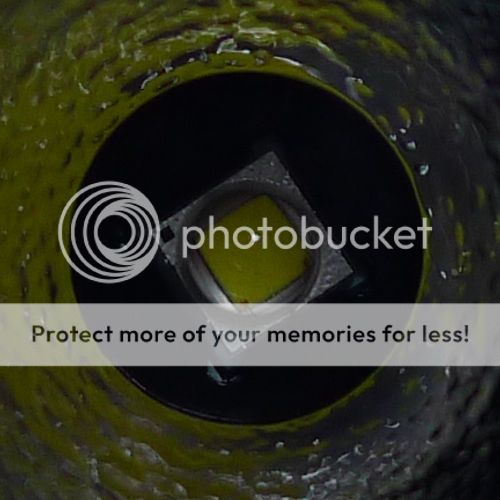
Here the head's cross-sectional shape can be seen, as can the textured reflector.
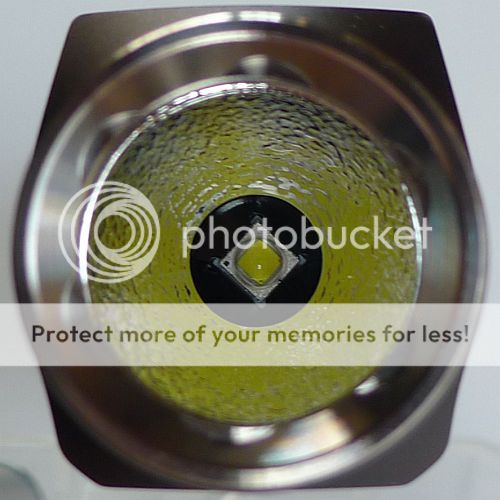
Whipping off the head reveals the head's terminals.
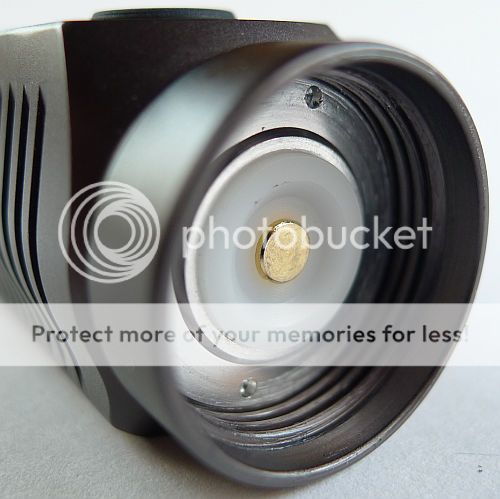
Inside the battery tube the negative terminal is a spring.
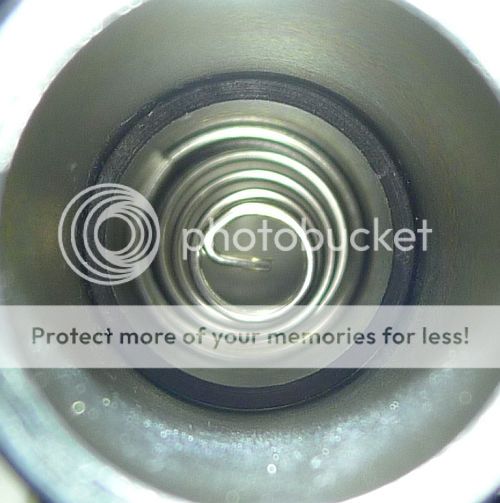
The threads are well formed and fully anodised (which allows lock-out). The tube walls are thick making this very robust.
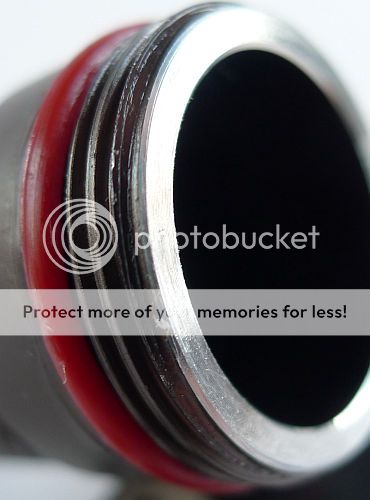
The battery fit is surprisingly loose, but despite this, in use there is no battery movement at all.
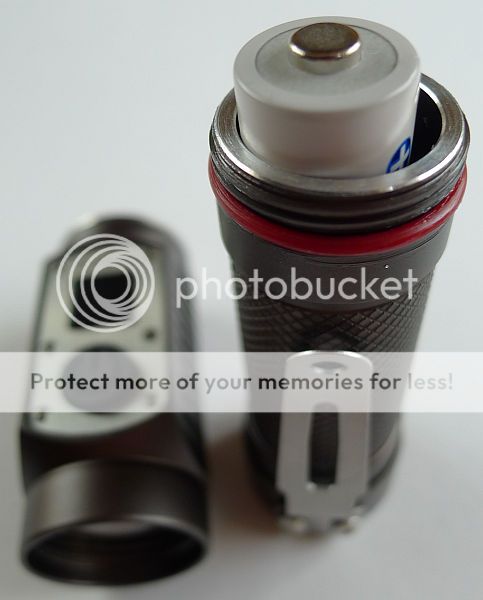
An AA battery gives an idea of scale.
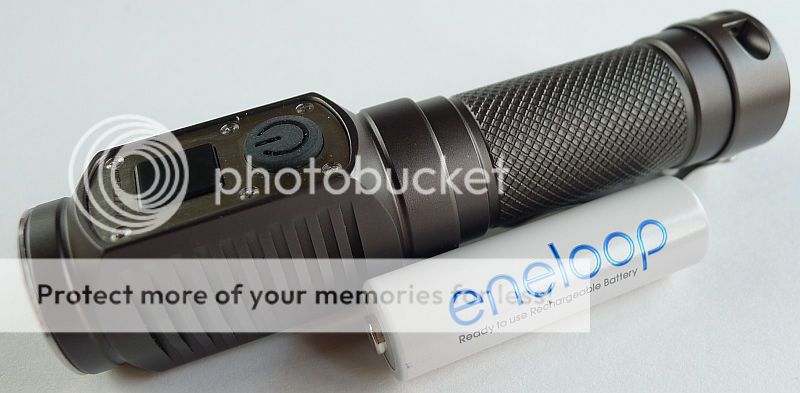
In the tail cap there is a threaded hole which Jetbeam advertise as having a glass breaker attachment. Fortunately, this hole has the same thread as a camera, so the DDA10 can be fixed to a tripod and aimed where you want it – a useful extra feature.
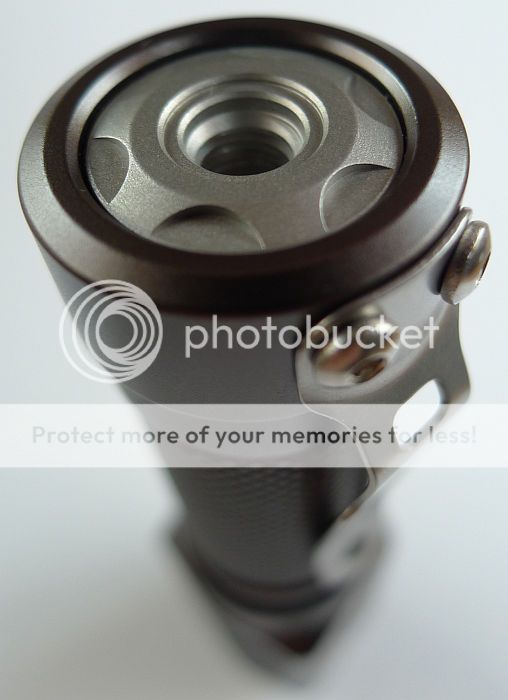
Modes and User Interface:
The DDA10 has four modes, High, Medium and Low, plus a Strobe.
Brief presses of the power switch give momentary output on High.
Pressing and holding the button for about 2s turns the DDA10 on in High, and the Display shows an 'H'
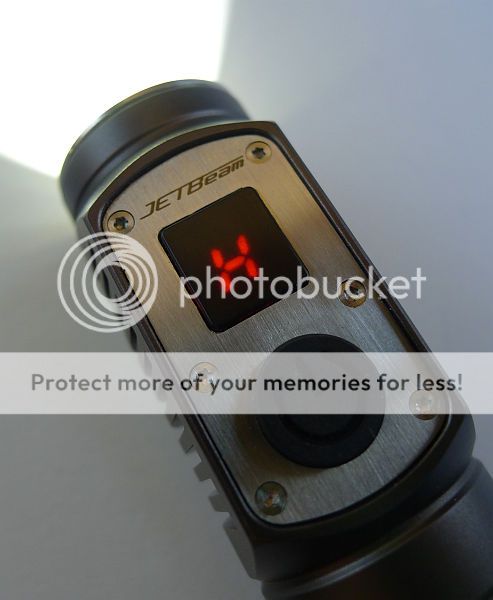
After a couple of seconds the display then switches to the battery level display. This shows a number from 9 down to 0 to represent the state of charge of the battery.
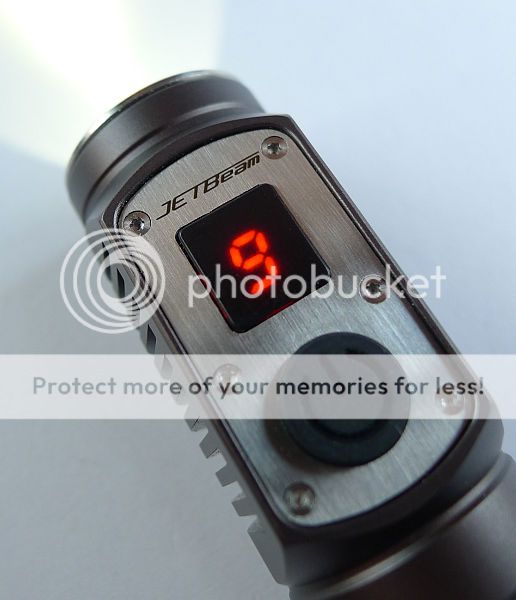
Pressing the button briefly while on, changes the mode to Medium – strangely represented by an E
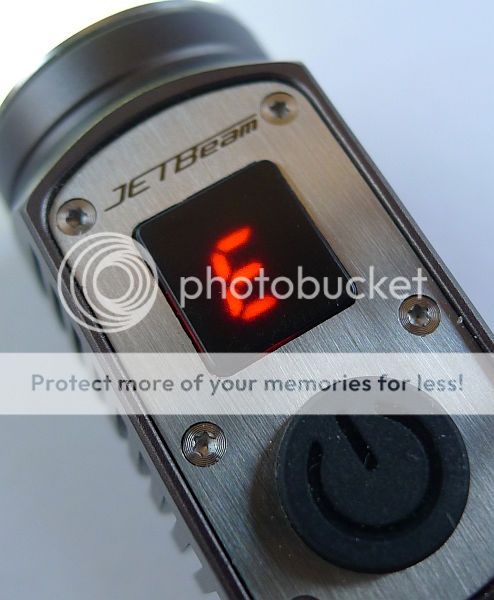
And a further press gives Low
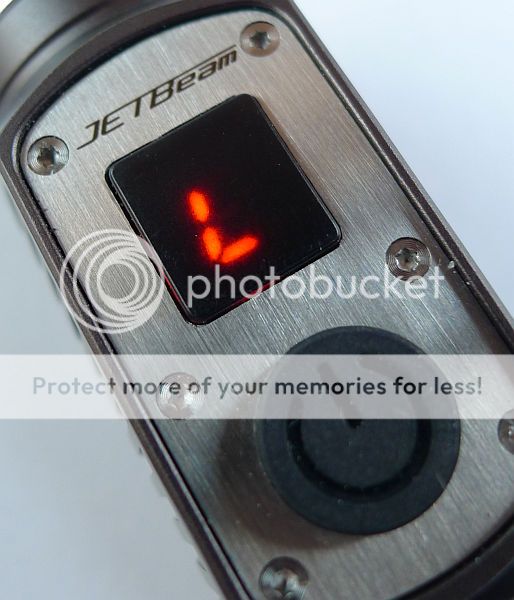
If you double click the switch, the DDA10 enters strobe. A single click returns the output to the last used constant mode.
To switch off press and hold the switch for 1s and the display and light goes out.
Batteries and output:
Simply the DDA10 will take any standard AA cell.
The testing was carried out with Eneloop Ni-Mh cells.
To measure actual output, I built an integrating sphere. See here for more detail. The sensor registers visible light only (so Infra-Red and Ultra-Violet will not be measured).
Please note, all quoted lumen figures are from a DIY integrating sphere, and according to ANSI standards. Although every effort is made to give as accurate a result as possible, they should be taken as an estimate only. The results can be used to compare outputs in this review and others I have published.
Strobe runs at 11.7Hz
As the DDA10 utilises an electronic switch, there is parasitic drain to consider.
The drain was measured at 0.37mA. As there is only a single AA, the parasitic drain will fully deplete a fresh batteries in 0.62 years. However due to the design of the end cap, it is easy to lock-out the DDA10 with a half turn of the battery tube and completely remove the drain.
The output is pretty well regulated, and maintains maximum output for the entire runtime test. Once the battery can no longer maintain maximum output it drops to Low for a good while longer so you won't be suddenly completely without light.
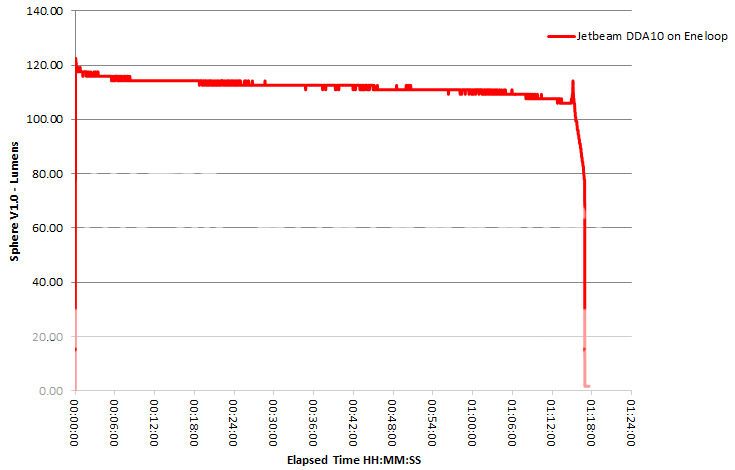
In The Lab
NEW for Winter 2012 ANSI standards include maximum beam range. This is the distance at which the intensity of light from an emitter falls to 0.25lux (roughly the same as the lux from a full moon). This standard refers only to the peak beam range (a one dimensional quantity), so I am expanding on this and applying the same methodology across the entire width of the beam. From this data it is possible to plot a two-dimensional 'beam range profile' diagram which represents the shape of the illuminated area.
In order to accurately capture this information a test rig was constructed which allows a lux meter to be positioned 1m from the lens and a series of readings to be taken at various angles out from the centre line of the beam. As the rig defines a quadrant of a circle with a radius of 1m, all the readings are taken 1m from the lens, so measuring the true spherical light intensity. The rig was designed to minimise its influence on the readings with baffles added to shield the lux meter from possible reflections off the support members.
The distance of 1m was chosen as at this distance 1lux = 1 candela and the maximum beam range is then calculated as the SQRT(Candela/0.25) for each angle of emission.
In this plot, the calculated ANSI beam ranges are plotted as if viewed from above (for some lights there may also be a side view produced) using a CAD package to give the precise 'shape' of the beam.
For the DDA10 we only need the 5m range grid (though slightly extended). The DDA10's beam profile is geared toward throw, but the hotspot edges are graduated smoothly into the spill.
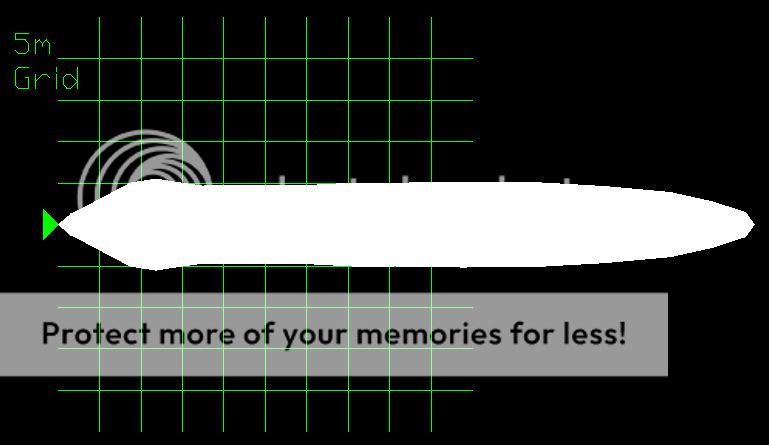
The beam
The indoor beamshot shows the smooth hotspot. However, slightly disappointing is the slight corona surrounding the hotspot.
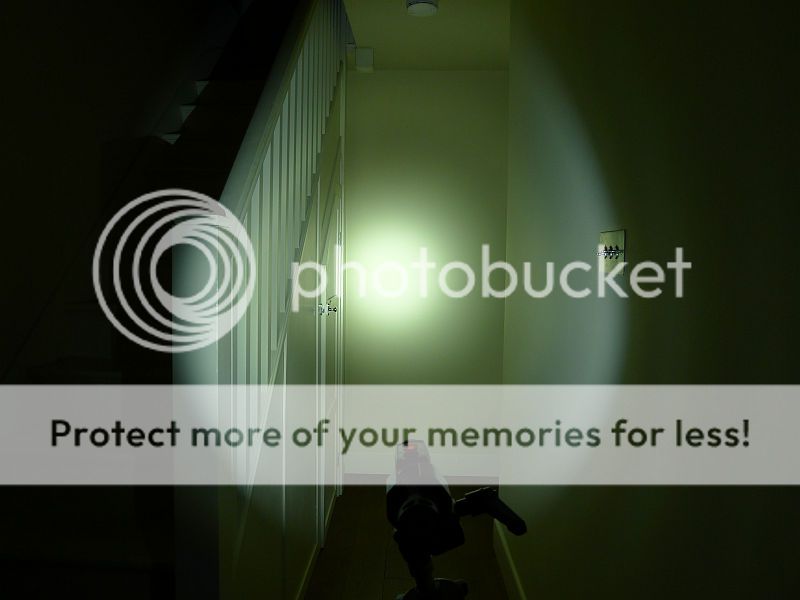
What it is really like to use…
I've certainly found it hard to put the DDA10 down. It is a very pleasing size and weight and the use of a side switch makes this so comfortable to use.
The switch has a firm click, and I'd prefer it if there was an option to remove the momentary function and just have it switch on straight away. Holding the button down for 2s is a bit annoying.
As the display comes on once the output is latched on, you know when you can let go of the switch for it to stay on. The same goes when turning it off, so this does help make the holding the switch for 2s to switch-on less painful.
Always coming onto High is a little limiting. If it could come on into the last-used mode, you could then switch on in Low. Having the display means you wouldn't ever be confused by this as it tells you exactly which mode you are in.
The low level is very usable for middle of the night movements, but to get there you'll need to cover the lens while you –press and hold for 2s, click for Medium and click for Low.
The display is a revelation. No battery voltage to convert into a state of charge, just a simple 9 down to 0 to let you know how much fuel is in the tank. This feature has worked predictably and reliably throughout all of my testing (which has included many cells and lots of use).
The parasitic drain is higher than I would like, but the simple twist to lock out the power makes this unimportant. As the DDA10 can determine the state of charge of a newly fitted cell even if it is partially depleted, using the lockout does not cause any problems at all.
The live battery status is something we are used to on our phones and other mobile devices, but now you can have this in a flashlight and benefit from the peace of mind it gives you to know how much longer it is going to run.
The red LED multi-segment display harks back to the first LED displays and I found myself feeling quite nostalgic (showing my age now). The mix of completely modern flashlight with retro looking display is something I really like.
Simple though it may be, the information provided by the DDA10'a display is really useful, and the side button operation very comfortable. The resulting extra size and weight just makes the DDA10 really nice to hold.
I've found this display to be a major benefit and look forward to the next development of this technology.
Test sample provided by JETBeam for review.
On test is the single AA powered DD light, the DDA10.
Initial Impressions:
The square head makes the DDA10 seem a little chunky at first for a single AA light, but the square cross section makes it sit in the hand nicely and is a fantastic anti-roll feature.
Of course this square head is needed to incorporate the extra circuitry to drive the display to house the display itself.
Having the display panel is one thing, but the panel also incorporates the power switch making this very intuitive to hold and operate. There is no tail switch, just the side switch.
The finish is flawless and build quality seems excellent.
Its shape, quality of finish and weight, all go together to make this a difficult light to put down.

What is in the box:
The DDA10 arrives in a cardboard box.

There is a foam cut out to protect the DDA10

Included are the DDA10, pocket clip with spare screws, allen key, lanyard, instructions, and a spare o-ring.

Taking a closer look and looking inside:
The DDA10'a display and button is secured by six small torx screws

After fitting the pocket clip, one of the design features becomes more obvious, that of the rotating tail cap. This allows the user to position the pocket clip at any point around the body of the DDA10.
Underneath the square head, the model information is printed onto the anodizing. The two sides of the head have small fins for heatsinking.

The power switch has a rubber boot and is an electronic click switch.

For the emitter. The DDA10 has an XP-G2 LED

Here the head's cross-sectional shape can be seen, as can the textured reflector.

Whipping off the head reveals the head's terminals.

Inside the battery tube the negative terminal is a spring.

The threads are well formed and fully anodised (which allows lock-out). The tube walls are thick making this very robust.

The battery fit is surprisingly loose, but despite this, in use there is no battery movement at all.

An AA battery gives an idea of scale.

In the tail cap there is a threaded hole which Jetbeam advertise as having a glass breaker attachment. Fortunately, this hole has the same thread as a camera, so the DDA10 can be fixed to a tripod and aimed where you want it – a useful extra feature.

Modes and User Interface:
The DDA10 has four modes, High, Medium and Low, plus a Strobe.
Brief presses of the power switch give momentary output on High.
Pressing and holding the button for about 2s turns the DDA10 on in High, and the Display shows an 'H'

After a couple of seconds the display then switches to the battery level display. This shows a number from 9 down to 0 to represent the state of charge of the battery.

Pressing the button briefly while on, changes the mode to Medium – strangely represented by an E

And a further press gives Low

If you double click the switch, the DDA10 enters strobe. A single click returns the output to the last used constant mode.
To switch off press and hold the switch for 1s and the display and light goes out.
Batteries and output:
Simply the DDA10 will take any standard AA cell.
The testing was carried out with Eneloop Ni-Mh cells.
To measure actual output, I built an integrating sphere. See here for more detail. The sensor registers visible light only (so Infra-Red and Ultra-Violet will not be measured).
Please note, all quoted lumen figures are from a DIY integrating sphere, and according to ANSI standards. Although every effort is made to give as accurate a result as possible, they should be taken as an estimate only. The results can be used to compare outputs in this review and others I have published.
| Jetbeam DDA10 | I.S. measured ANSI output Lumens | PWM frequency (Hz) |
|---|---|---|
| High | 118 | 25000 |
| Medium | 23 | 0 |
| Low | 2 | 0 |
Strobe runs at 11.7Hz
As the DDA10 utilises an electronic switch, there is parasitic drain to consider.
The drain was measured at 0.37mA. As there is only a single AA, the parasitic drain will fully deplete a fresh batteries in 0.62 years. However due to the design of the end cap, it is easy to lock-out the DDA10 with a half turn of the battery tube and completely remove the drain.
The output is pretty well regulated, and maintains maximum output for the entire runtime test. Once the battery can no longer maintain maximum output it drops to Low for a good while longer so you won't be suddenly completely without light.

In The Lab
NEW for Winter 2012 ANSI standards include maximum beam range. This is the distance at which the intensity of light from an emitter falls to 0.25lux (roughly the same as the lux from a full moon). This standard refers only to the peak beam range (a one dimensional quantity), so I am expanding on this and applying the same methodology across the entire width of the beam. From this data it is possible to plot a two-dimensional 'beam range profile' diagram which represents the shape of the illuminated area.
In order to accurately capture this information a test rig was constructed which allows a lux meter to be positioned 1m from the lens and a series of readings to be taken at various angles out from the centre line of the beam. As the rig defines a quadrant of a circle with a radius of 1m, all the readings are taken 1m from the lens, so measuring the true spherical light intensity. The rig was designed to minimise its influence on the readings with baffles added to shield the lux meter from possible reflections off the support members.
The distance of 1m was chosen as at this distance 1lux = 1 candela and the maximum beam range is then calculated as the SQRT(Candela/0.25) for each angle of emission.
In this plot, the calculated ANSI beam ranges are plotted as if viewed from above (for some lights there may also be a side view produced) using a CAD package to give the precise 'shape' of the beam.
For the DDA10 we only need the 5m range grid (though slightly extended). The DDA10's beam profile is geared toward throw, but the hotspot edges are graduated smoothly into the spill.

The beam
The indoor beamshot shows the smooth hotspot. However, slightly disappointing is the slight corona surrounding the hotspot.

What it is really like to use…
I've certainly found it hard to put the DDA10 down. It is a very pleasing size and weight and the use of a side switch makes this so comfortable to use.
The switch has a firm click, and I'd prefer it if there was an option to remove the momentary function and just have it switch on straight away. Holding the button down for 2s is a bit annoying.
As the display comes on once the output is latched on, you know when you can let go of the switch for it to stay on. The same goes when turning it off, so this does help make the holding the switch for 2s to switch-on less painful.
Always coming onto High is a little limiting. If it could come on into the last-used mode, you could then switch on in Low. Having the display means you wouldn't ever be confused by this as it tells you exactly which mode you are in.
The low level is very usable for middle of the night movements, but to get there you'll need to cover the lens while you –press and hold for 2s, click for Medium and click for Low.
The display is a revelation. No battery voltage to convert into a state of charge, just a simple 9 down to 0 to let you know how much fuel is in the tank. This feature has worked predictably and reliably throughout all of my testing (which has included many cells and lots of use).
The parasitic drain is higher than I would like, but the simple twist to lock out the power makes this unimportant. As the DDA10 can determine the state of charge of a newly fitted cell even if it is partially depleted, using the lockout does not cause any problems at all.
The live battery status is something we are used to on our phones and other mobile devices, but now you can have this in a flashlight and benefit from the peace of mind it gives you to know how much longer it is going to run.
The red LED multi-segment display harks back to the first LED displays and I found myself feeling quite nostalgic (showing my age now). The mix of completely modern flashlight with retro looking display is something I really like.
Simple though it may be, the information provided by the DDA10'a display is really useful, and the side button operation very comfortable. The resulting extra size and weight just makes the DDA10 really nice to hold.
I've found this display to be a major benefit and look forward to the next development of this technology.
Test sample provided by JETBeam for review.

